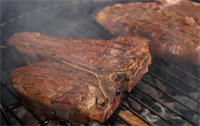 T-bone vs. Porterhouse
T-bone vs. Porterhouse
Many people who order steaks at a restaurant simply don’t know how to differentiate one from the other. To shed some light on the subject, the difference between the two is that, although the two cuts look very similar, a T-Bone has a T-shaped bone with a larger piece of meat on one side, whereas the meat is less on the other type of cut. Nevertheless, both cuts come from the short loin ‘“ the tender section of muscle located in between the rib and the sirloin.
The short loin is composed of the top loin and the tenderloin. T-Bones are cut from the center of the short loin, as opposed to the Porterhouse which is cut from the larger end. Thus, the T-Bone will have a smaller piece of the tenderloin than the Porterhouse. Moreover, the Porterhouse generally contains more marbling ‘“ streaks of fat distributed throughout the steak which contributes to its tenderness and juiciness.
In the U.S., the Meat Packers Association says that to be classified as a T-Bone the cut should be 1/2inch (13mm) thick at its widest. On the other hand, the Porterhouse should be 1.25 inches (32mm) thick. Like the T-Bone, the Porterhouse is also two steaks in one. On one side you have the New York strip, and on the other side is the fillet. Although, it is evident that the Porterhouse has a larger sized fillet portion.
In Britain, and some commonwealth countries, except Canada however, a Porterhouse refers only to the short loin; to which the U.S. regards as a strip loin. That’s why customers from the U.S must be cautious in ordering a steak at a British restaurant or pub. If you think you will get an American style Porterhouse, you probably won’t.
In conclusion, if you go to a restaurant and see T-Bone and Porterhouse on the menu, priced the same, you will get more value for your money ordering a Porterhouse. To further summarize:
1. A T-Bone steak looks like two steaks in one. On one side you have the bone strip loin, and on the other a nice piece of fillet mignon.
2. A T-Bone is usually thinner than a Porterhouse. It has a smaller section of fillet attached, and is usually less tender than a Porterhouse.
3. A Porterhouse has a top loin and tenderloin. It is thicker than a T-Bone. It also has less bone and has more marbling on its surface.
Additional Info:
Origin of Porterhouse
It is rumored that the origin of this now famous name began in 1892, in New York.
A tavern owned by Martin Morrison was a favorite place for seafarers to dine.
An old pilot called out for a steak, but there was none left. So Morrison said he would cut and broil from the sirloin he was preparing for the next day. It became such a success that from that day on Morrison ordered only the same cut of sirloin from his butcher. It is also said that Mark Twain’s (the famous American novelist) favorite meal was that of pan fried Porterhouse mushrooms and peas.
- Difference Between Plant Protein and Animal Protein - March 7, 2024
- Difference Between Crohn’s and Colitis - March 7, 2024
- Difference Between Expression and Equation - March 7, 2024
